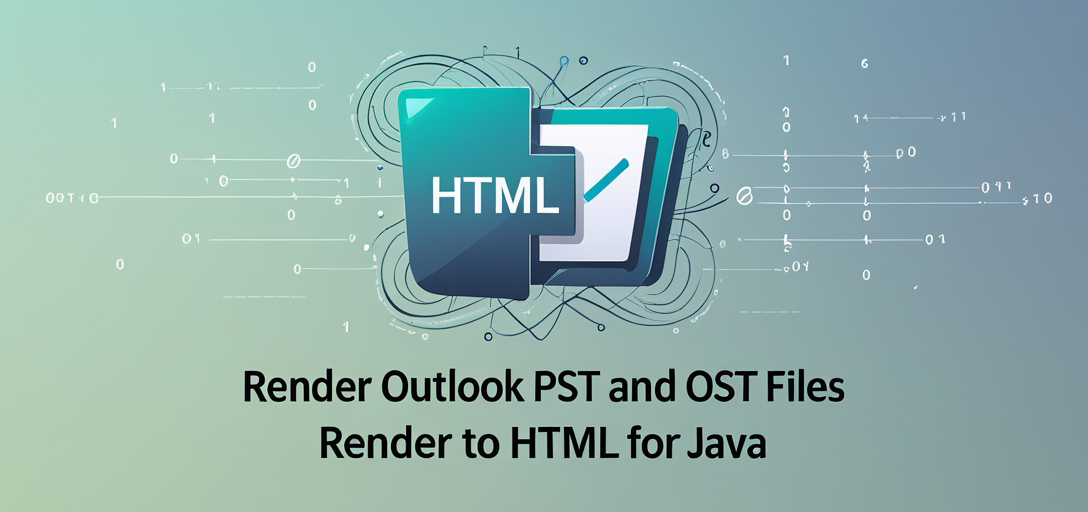How to Render Outlook Data Files to HTML Using GroupDocs.Viewer for Java
Introduction
Converting Outlook PST and OST files to HTML using Java can streamline data accessibility in web applications or automate email processing tasks. This tutorial leverages the power of GroupDocs.Viewer for Java, a powerful library for rendering various document types, including Outlook data files.

By following this guide, you’ll learn how to:
- Set up GroupDocs.Viewer in your Java project
- Retrieve view information from Outlook data files (PST/OST)
- Render these files into HTML format
This tutorial ensures a clear understanding of implementing this functionality efficiently. Let’s start by reviewing the prerequisites for setting up your development environment.
Prerequisites
Before diving into the implementation, ensure you have:
- Required Libraries: GroupDocs.Viewer for Java version 25.2 or later.
- Environment Setup: A Java Development Kit (JDK) installed and an IDE like IntelliJ IDEA or Eclipse.
- Knowledge Base: Basic understanding of Java programming, Maven build system, and file handling in Java.
Setting Up GroupDocs.Viewer for Java
To use GroupDocs.Viewer for Java, follow these setup steps:
Maven Setup
Add the following configuration to your pom.xml file:
<repositories>
<repository>
<id>repository.groupdocs.com</id>
<name>GroupDocs Repository</name>
<url>https://releases.groupdocs.com/viewer/java/</url>
</repository>
</repositories>
<dependencies>
<dependency>
<groupId>com.groupdocs</groupId>
<artifactId>groupdocs-viewer</artifactId>
<version>25.2</version>
</dependency>
</dependencies>
License Acquisition
Obtain a temporary license to fully evaluate GroupDocs.Viewer’s capabilities without limitations by visiting the Temporary License page.
Basic Initialization and Setup
Once the dependency is added, initialize the Viewer class with your Outlook data file path. This sets the stage for rendering.
Implementation Guide
The process is divided into manageable sections focusing on each feature:
Overview of Rendering Functionality
This feature allows extracting information from an Outlook data file and rendering it as HTML.
Step 1: Import Necessary Packages
Start by importing essential classes required for rendering:
import com.groupdocs.viewer.Viewer;
import com.groupdocs.viewer.options.ViewInfoOptions;
import com.groupdocs.viewer.results.OutlookViewInfo;
These imports bring in the necessary tools to handle and convert Outlook data files.
Step 2: Specify Output Options
Define your document rendering preferences using ViewInfoOptions for HTML:
ViewInfoOptions viewInfoOptions = ViewInfoOptions.forHtmlView();
This configuration specifies that the output format should be HTML, aligning with our goal of web accessibility.
Step 3: Obtain and Display View Information
Use a try-with-resources statement to manage the Viewer instance efficiently:
OutlookViewInfo viewInfo;
try (Viewer viewer = new Viewer("YOUR_DOCUMENT_DIRECTORY/SAMPLE_OST_SUBFOLDERS")) {
viewInfo = (OutlookViewInfo) viewer.getViewInfo(viewInfoOptions);
}
Here, a Viewer object is initialized with the path to your Outlook file, and view information is retrieved using specified options. This step accesses folder details and other metadata.
Display essential details about the data file:
System.out.println("File type is: " + viewInfo.getFileType());
System.out.println("Pages count: " + viewInfo.getPages().size());
for (String folder : viewInfo.getFolders()) {
System.out.println(folder);
}
This code outputs the file type, page count, and lists all folders within the Outlook data file. These insights can be valuable for further processing or display.
Troubleshooting Tips
- File Path Issues: Ensure the specified path in
new Viewer()is correct. - Dependency Conflicts: Check project dependencies to avoid conflicts with other libraries using Maven.
Practical Applications
Rendering Outlook data files to HTML has several real-world applications:
- Email Archiving Systems: Automatically convert and store email archives for easy access on web platforms.
- Customer Support Tools: Integrate into helpdesk software to display customer emails in a user-friendly format.
- Data Migration Projects: Facilitate the transfer of email data from legacy systems to modern applications.
Performance Considerations
When working with large Outlook files, consider:
- Optimizing memory usage by configuring Java heap size appropriately.
- Using asynchronous processing for rendering tasks to prevent blocking operations.
- Caching rendered HTML pages if accessed frequently, reducing load times and server strain.
Conclusion
You’ve learned how to render Outlook data files into HTML using GroupDocs.Viewer for Java. This capability enhances applications by providing seamless access to email content in web-friendly formats.
Explore additional features of GroupDocs.Viewer or integrate this functionality into larger projects to maximize its benefits. If you found this guide helpful, consider implementing it in your next project!
FAQ Section
Q1: How do I handle large Outlook files? A1: Optimize memory and consider asynchronous processing for better performance.
Q2: Can GroupDocs.Viewer convert other file formats to HTML? A2: Yes, it supports various document types including Word, Excel, PDFs, and more.
Q3: What is the difference between temporary and full licenses? A3: Temporary licenses are trial versions with limited features, while full licenses unlock all capabilities without restrictions.
Q4: Is GroupDocs.Viewer compatible with cloud environments? A4: Yes, it can be integrated into cloud applications via its REST API or Java SDKs.
Q5: How do I debug issues during rendering? A5: Check the file path and ensure dependencies are correctly configured. Consult the GroupDocs Support Forum for more help.
Resources
- Documentation: GroupDocs Viewer Java Documentation
- API Reference: GroupDocs API Reference
- Download: GroupDocs Releases
- Purchase and Licensing: Buy GroupDocs Viewer
- Free Trial: Try Free Version